Snow, sky and outer space
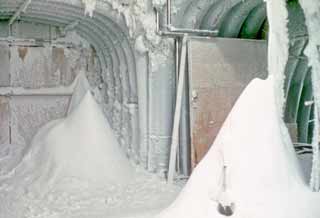
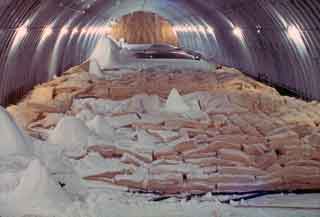 The fuel arch as we knew it. There were 9 bladders (rubberized "bags") each which could hold 25,000 gallons of DFA. In our day the fuel arch was not yet buried, so the snow would find its way in and fill the place up. Several times during the winter we did LOTS of work to manually shovel this stuff onto banana sleds and haul it out the door at the far end of the arch. Also since the arch wasn't buried with an insulating layer of snow, the place got colder than it does now. Under the fiberglass insulation we had electric heat blankets to keep the fuel from turning into jello. Nowadays the place burns a different flavor of fuel which stays liquid at colder temperatures.And also nowadays, in the 98-99 summer these bladders were replaced with steel tanks. This will eliminate the leakage problems (the tanks are set on top of containment "boats" to collect spills). The 45 new tanks remained as part of the new station, now the total fuel storage in the arch has been doubled to 450,000 gallons...with more storage in steel tanks mostly at the End of the World. Oh yes, the current station burns about 3 times the fuel that we used in 1976-77.
The fuel arch as we knew it. There were 9 bladders (rubberized "bags") each which could hold 25,000 gallons of DFA. In our day the fuel arch was not yet buried, so the snow would find its way in and fill the place up. Several times during the winter we did LOTS of work to manually shovel this stuff onto banana sleds and haul it out the door at the far end of the arch. Also since the arch wasn't buried with an insulating layer of snow, the place got colder than it does now. Under the fiberglass insulation we had electric heat blankets to keep the fuel from turning into jello. Nowadays the place burns a different flavor of fuel which stays liquid at colder temperatures.And also nowadays, in the 98-99 summer these bladders were replaced with steel tanks. This will eliminate the leakage problems (the tanks are set on top of containment "boats" to collect spills). The 45 new tanks remained as part of the new station, now the total fuel storage in the arch has been doubled to 450,000 gallons...with more storage in steel tanks mostly at the End of the World. Oh yes, the current station burns about 3 times the fuel that we used in 1976-77.
 At left, John (driving the 955 forklift) and Lloyd in the yellow NZARP parka) run out for some gas (pallets of helium bottles for the weather balloons). 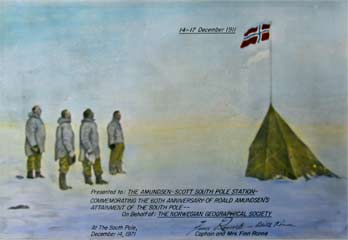 At right, a closeup of one of the plaques on our galley wall depicting Amundsen's team at Pole (here's the companion plaque showing Scott's party at the tent). Captain Finn Ronne and his wife Edith had brought these here in 1971-72, something we didn't know in 1977. Several years later, all this stuff including Admiral Byrd's sweater got moved up to the pool room, where it was until that dome building was demo'd in 2006. Now many of these items are displayed in various places in the elevated station, although I haven't seen the Admiral's sweater in this century. At one point during my time at Pole in the 1980's, a member of the science community claimed he had a scheme to recover Amundsen's tent using ground penetrating radar, combined with accurate data on the movement of the glacier and the snow accumulation since 1911. The plan was to take the tent back to Norway for a museum. Well, since Amundsen somehow neglected to bring a GPS with him, I think that might have been a bit difficult. I never heard another word about it while on the ice. HOWEVER... a few years later the Norwegian glaciologist Monica Kristensen, who led one of the first NGO expeditions to Pole (from the Bay of Whales in 1986-87, they turned around 280 miles short) came looking for it. She led the "Aurora Challenge" expedition from the Patriot Hills side in 1993-94, they really expected to retrieve Amundsen's tent and flag and take them back to display at the 1994 Olympic Winter Games in Lillehammer. That never worked; team member Jostein Helgested died from a fall into a 120-foot crevasse. The SAR effort was staged through Pole. SAR team member Steve Dunbar tells a harrowing story of the landing and his descent into the crevasse; the story and other details are here. Meanwhile Amundsen's tent remains where he left it, and it is now protected by an Antarctic Treaty resolution. 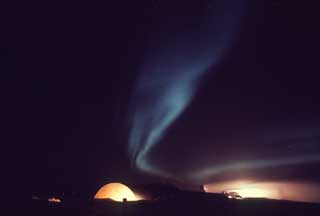
Here's an aurora shot from near Clean Air, looking toward the fuel arch and station. My normal method was to use 400 film with a wide-angle lens, and tripod and cable release. I'd open the lens up and hold the shutter open for 45-60 seconds. Others have done more sophisticated things with heated camera boxes etc., and of course there was the art of shooting the sky through the domes in Skylab. On one of my pictures the camera froze with the lens stuck open. I put the lens cover on and brought the camera inside to thaw out. About 45 minutes later I tapped the camera and the shutter clicked shut. Here's that picture. 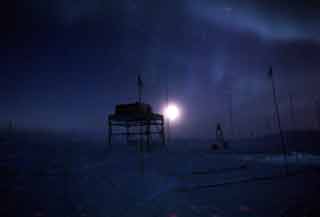 The cosmic ray detectors behind Skylab are illuminated by auroras, moonlight, and, well, some camera static electricity. The SATTRACK antenna is to the right of the moon.
The cosmic ray detectors behind Skylab are illuminated by auroras, moonlight, and, well, some camera static electricity. The SATTRACK antenna is to the right of the moon.
This is my only 76-77 picture of these 3 big red boxes which got installed during our summer. They consisted of detector tubes encased in lead shielding. The principal investigator for the cosmic ray studies was Marty Pomerantz, who showed up to commission our cosray lab on the second floor of Skylab. Earlier in the summer Stu ran the old cosray lab at Old Pole for several days to collect baseline data for the new system; those detector tubes were simpler and smaller and buried in a pile of lead bricks (a few of which may still be around the station here and there). Oh yes, the cosray detectors were on a jackable platform. It was jacked up more than once; one time was while I was around in the late 80's. And more recently, in 2009-10 the platform and detectors were moved away from the old dome location. Below left is the Skylab under a full moon (1978 Kevin Bisset photo), with the light on in the second floor cosray lab. 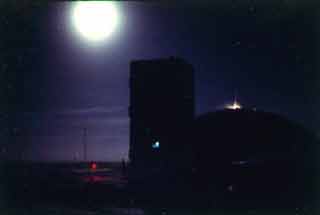
Marty had been actively involved with cosmic ray studies at McMurdo and Pole since the 1959-60 season; an early bit of this history is that the original cosray lab at McM was built and set up before Dr. Pomerantz found out that there was to be a nuclear power plant constructed nearby--which of course would mess up the data. That's why the later/present McM cosray lab was built on the Pass road so that Ob Hill would shield the detectors from the power plant radiation. The original McMurdo cosray lab was later shipped to Old Pole--that was the one we dug out during the 1976-77 summer. A few years after our winter he branched into astronomical studies at Pole...including some of the early submillimeter telescopes (his seminal project). Some of his earlier astronomical work was done in "Pomerantz Land" during summers in the late 80's using temporary structures. Since those studies proved successful, nowadays there is the dark sector, a bunch of telescopes, and the permanent "MAPO" (Martin A. Pomerantz Observatory) building named in his honor. |
